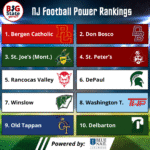It is getting close to All-County time, when I receive coaches’ all-county nominations, sift through the numbers, strength of schedules, teams’ successes (or failures) and my observations, put it all into a blender, and assemble the final product.
Is it perfect? Absolutely not! This is just what I have come up with.
It is a fascinating, arduous process that I have been doing almost every year since 1984.
Great athletes deserve to be recognized and this is a terrific way to wrap up the season and honor the best kids and the top teams.
This year, some positions are obvious and some are extremely difficult.
I am getting a complete handle on Sussex and Morris counties and will be running:
The week of Nov. 24: All-Sussex (with Hackettstown, Warren Hills and North Warren).
The week of Dec. 1: All-Morris.
The week of Dec. 8: All-Area.
It is sad to say that the local news organizations do NOT do any All-County teams in the same fashion that Sean Reilly (Star-Ledger) and I (Daily Record) used to. That’s when we sorted through the coaches’ nominations and input, and assembled All-County or All-Area.
It was EASILY one of the most popular sports sections of the entire year, and why news organizations fail to put one together is positively mind boggling.
Nowadays, the Daily Record runs Morris’ coaches’ all-county (which is the best senior on each team, basically … NOT a true all-county team!).
The Star-Ledger/NJ.com might run coaches all-division (which ran in this space last week, in case you missed it).
But here is the problem with using that as your final way to honor the kids: There are roughly six teams per division, so there is no real whittling-down process. The Star-Ledger/NJ.com has an excellent staff (Luis Torres, Mike Kinney, Joe Zedalis, etc.) made up of guys who are really into high school football and know their stuff.
But for some reason, they are kept from putting together an all-county team.
All an editor has to give them the green light to assemble an all-county team and they’d do a great job.
But for whatever reason, someone is tying their hands behind their backs.
So having gathered up all the information, here is what I have come up with this far.
Team of the Year
Is the team of the year necessarily the best team? No! In my early Daily Record days, that is the way I chose Team of the Year but I changed my tune. It could well be the best team, but sometimes a team can get hot and go on a state-championship run (like Hanover, Butler or Pope John).
Sometimes, a team can run the table and be great … but that is what they were supposed to do. Is that a Team of the Year? Maybe yes, maybe no.
To me, it is not always the best team (though it could be, depending on the season). One year in wrestling, Mount Olive won the state team title in Group IV. But they were not close to being on Delbarton’s level. So Mount Olive was my team of the year. If there was no other Mount Olive-type of breakthrough team, I could well have given Team of the Year to Delbarton. It all depends on the season.
Delbarton is the best football team in the area this year, let’s be clear about that. But they will not be my Team of the Year.
I will say this: When a team reaches a height it has never reached or hasn’t reached in a very long time, that has a lot of sway with me.
So let’s wait and see how this all pans out.
Coach of the Year
There are a number of candidates this year, many of whom are in different categories.
Butler’s Jason Luciani guided the Bulldogs to a sectional championship and has kept the program at a high level for a long period of time. Butler won the NJIC championship for the first time since going to the Bergen-Passaic conference in 2018.
Mountain Lakes’ Darrell Fusco suffered a load of graduation losses and somehow guided the Herd to a sectional final (fourth straight) despite a rash of injuries. Fusco’s team started out 0-3 and won six of its last eight games. Terrific in-season coaching (and a little help from the schedule maker!).
High Point’s Bill Percey lifted the Wildcats to one of the best seasons in school history. High Point won the American Blue.
Morris Knolls’ Bryan Gallagher took over for a legend (49-year coach Bill Regan) and guided the team to a Liberty White undefeated title and then further in the playoffs than it had since 2005 (Knolls last state championship).
Hanover Park’s Dan Fulton brought home the Hornets’ first sectional title since 1990 – 34 years is a long, long time. Not many people saw this coming.
Chatham’s Evan Picariello staged the 2024 season’s biggest surprise (31-6 win over Mount Olive) and guided the Cougars to a sectional semifinal. Again, raise your hand if you saw that coming back in the summer months.
Pope John’s Dom Gaston led the Lions to a 14-10 victory over Paramus Catholic in the second round of the Parochial B playoffs after suffering a 49-29 loss back in September. Kudos to him and his staff. That kind of turnaround doesn’t happen too often.
Mendham coach Ethan Jeros guided the program to its first divisional title of any sort since 2004.
Player of the Year
I think I know where I am going with this, but don’t want to tip my hand. Here are some of the finalists. Lots of talented players out there this year!
Will Allen (Chatham) – The Cougars were not supposed to be much of a threat this year but were surprising contenders in the Liberty Blue. The spearhead of the surprising year was Allen at QB (157 for 270, 2,022 yards, 17 TDs, 6 INTs)
Brady Bentrewicz (West Morris) – The Wolfpack were loaded with good players again and Bentrewicz was the best when it comes to all-around performance. He was 95 for 968 (7 TDs) in a balanced running attack and caught 12 passes for 247 yards (3 TDs) for a team that almost never throws. He was in on 38 tackles from his defensive back spot.
Joey Borrello (Hanover Park) – It is rare for a quarterback to have a strong year passing AND running but that is what Borrello has been able to do in helping the team win its first sectional title since 1990. He is 108 for 146 passing for 1,558 yards and 18 TDs with just five INTs. He is a threat running with the ball (126 for 452, 11 TDs). His improvement from last year is striking and a big key to the Hornets’ rapid rise to North 2, Group 2 champions.
Bobby Brickner (Morris Knolls) – Brickner made life a little easier for first-year coach Bryan Gallagher. All Brickner did for the North 2, Group 4 finalists was rush 189 times for 1,366 yards and 12 TDs and play a terrific linebacker (1 sack, 9 tackles for loss, 85 tackles, 1 forced fumble, 1 recovery, 2 INTs).
Cole Capuzzi (Mendham) – The Minutemen had a terrific season and Capuzzi was in the middle of things for the Liberty Blue champions (first for the school since 2004) by carrying 169 times for 1,181 yards (7.0) and 17 touchdowns. He did all of that despite missing about 12 quarters of the season because Mendham was in the process of blowing out a lot of teams this year.
P.J. Coffey (Butler) – Bulldogs coach Jason Luciani has spent a lot of years coaching at the school and said Coffey is the best all-around player he has ever had and it would be hard to argue. Coffey is a threat running the ball (51 for 376, 9 TDs) and out of the backfield (34 catches for 606 yards, 13 TDs) for the NJIC and North 1, Group 1 champions. He also has a kick return for a touchdown. Defense? He also has 40 tackles and two INTs and single-handedly shuts down the opposing team’s top receivers.
Tyler Cumming (Mount Olive) – Few players had the two-way season Cumming had for the Marauders. He rushed 154 times for 1,121 yards and scored 11 touchdowns while being influential on defense (1 sack, 9 tackles for loss, 74 total tackles) for a sectional semifinalist.
Shane Hoover (Sparta) – Hoover (160 for 231, 2,265 yards, 30 TDs, 8 INTs) has a terrific arm and will be headed to Seton Hall University to pitch but football coaches have taken notice of what he could bring them on the football field (and so has Hoover, who is now open to listening to them). He took over an underachieving team at midseason as a sophomore last year (he was 87 for 137 for 1,146 yards, 12 TDs, 7 INTs) and the team immediately staged a revival.
Anthony Feaster (Montville) – There were few players as versatile as the Lehigh-bound Feaster, who was 76 for 475 yards rushing (9 TDs), caught 47 passes for 693 yards (5 TDs), made 32 tackles, forced three fumbles, recovered one, and intercepted four passes (returning one for a TD).
Phil Folmar (Delbarton) – Folmar has been a rare four-year starter for the United White champion Green Wave. He has been stellar as a senior (55 catches for 937 yards, 8 TDs) and was positively incredible (9 for 171, 3 TDs) in a wild 52-51 victory over DePaul, one of the top 3-4 teams in all of New Jersey.
Tylik Hill (Pope John) – There were a large number of great runners in Morris-Sussex this year, but only one is electric with the ball in his hands and that is Hill (264-1,916 yards, 21 TDs). He also caught 18 passes for 99 yards.
Nick Kurilko (Newton) – Kurilko is one of the best two-way players in the entire Morris-Sussex area. He has rushed for 933 yards and 14 TDs and caught 14 passes for another 143 yards. He has 1 sack and 13 tackles for loss to go with 70 tackles (one forced fumble). In the game of the year in Sussex County this year, he was all over the field in a 36-32 Newton win over High Point, he was 14 for 158 and three TDs and made 21 tackles (four for loss) and had an interception and 42-yard return that led to the go-ahead TD he scored with five minutes left in the game.
Jerron Martress (High Point) – Back in the summer, the junior wanted to play quarterback but Wildcats coach Bill Percey put Martress in the backfield and the kid never looked back, rolling up 1,671 yards and 26 TDs as High Point was the surprise team of Sussex County this year.
Jadon Prinzivalli (Delbarton) – Prinzivalli sat behind standout Christian Zebrowski last year but coach Brian Bowers told me in the summer there really wasn’t much difference between the two so he went with the senior. At another school, Prinzivalli (140 for 230, 2,083 yards, 16 TDs, 7 INTs against a demanding schedule) would have been a two-year standout, if not longer.
Wade Pickett retires
Lenape Valley coach Wade Pickett has announced that he is retiring from teaching and coaching at Lenape Valley.
“I will have 35 years in the system and on the sidelines and have decided to take a break and spend some time with the family,” said Pickett, who spent 32 years on the sideline either as a head man or assistant to legendary head man Don Smolyn at the school. He took over the Patriots when Smolyn retired in 2021.
“My favorite memories for me after 32 years at Lenape are all the friendships that I have made with the coaches and staff at Lenape and the relationships that I have made with all the players,” he said. “Obviously the state championship games and the big SCIL conference games are all memorable, as well my first win as a head coach vs Verona and the last home game vs. Wallkill are just some of the experiences I’ll treasure most.”
Three locals left in playoffs
There are three Morris-Sussex teams left in the state playoffs.
Butler at Cedar Grove (Friday)
The Bulldogs have one of the best teams in school history and are running on all cylinders. But the Cedar Grove game will be a stern test.
One local Group I coach believes Cedar Grove would win Group III this year and it is hard to argue. By that same token, Cedar Grove QB Stephen Paradiso (198 for 308, 3,120 yards, 36 TDs, 7 INTs) might well be worthy of first-team All-State at the position. Same goes for receivers Jackson Morrice (80 for 1,600, 19 TDs) and Nick Russo (65 for 708, 10 TDs).
Back in the day, some South Jersey voters were hung up on Group size when it came to voting and would NEVER vote for a small-school player such as Paradiso over a big-school player. It wouldn’t matter if Dan Marino played for a Group I school and Joe Schmo played QB for a Group IV school … that voter was raising his hand for Joe Schmo when it was time to vote!
Butler will try and counter Cedar Grove’s attack with QB David Smith (90 for 141, 1,377 yards, 26 TDs, 2 INTs), receiver PJ Coffey (34 for 606, 13 TDs) and running backs Coffey (51 for 376, 9 TDs) and Yadi Perez (84 for 595, 8 TDs) and Smith (84 for 604, 6 TDs).
Butler D-linemen Luca Toriello (3 sacks, 10 tackles for loss, 54 tackles) and Peyton Kibburz (4 sacks, 5 tackles for loss, 53 tackles) must come up big to upset Paradiso’s rhythm.
Shabazz at Hanover Park (Friday)
The Hornets have prided themselves on their speed and quickness are one of the few teams that can match Shabazz’s.
Joe Filippone (78 for 350 rushing, 3 TDs, 21 for 230 receiving, 2 TDs, 3 sacks, 14 tackles for loss, 93 total tackles) has been indispensable for Hanover.
The Newark school was moved up to Group II this year after spending time in Group I despite attracting athletes from all over Newark. The team has hit its stride after a 35-12 loss against Immaculata in midseason.
Shabazz’s rapid improvement after the Immaculata game may have come due to a sudden influx of transfers. Did anyone see Bernards coach Jon Simoneau’s quotes on Tapinto after his team lost to Shabazz last week?
“I’ve got to be honest, man, we got out-recruited. Write it. I mean that,” Simoneau told Guy Kipp. “I’m being very honest. It’s not sour grapes. The NJSIAA ain’t gonna do nothin’ about it. Actions speak louder than words, so they sent a loud message to every one of us, and we gotta start recruiting at the public schools, because the other public schools are allowed to. Back to the drawing board for some of what we do, but you can’t be upset about it, because they did it. It doesn’t take anything away from the kids, they played a good game today.
“Give credit to their coaching staff because those kids, they were only here for six games and look how well they played. Credit where credit’s due, because that’s not easy. They were able to take a group of kids not from (Newark) and get them to gel at the right time of year for the second time in a row. The state doesn’t stop it, so it’s what other public schools have to do, too.”
St. John Vianney at Pope John (Saturday)
The Lions defense had struggled stopping some of the best teams in New Jersey all year but came up big in a 14-10 win at No. 3 seed Paramus Catholic. That came after a 42-7 demolition over Camden Catholic one week earlier.
The Lions have all three levels covered with tackle Joe Pappa (2 ½ sacks, 10 tackles for loss, 33 tackles), linebacker Tyler Houser (5 sacks, 9 tackles for loss, 68 tackles), and D-Back Wes Johnston (2 sacks, 7 ½ tackles for loss, 67 tackles).
Vianney, which has lost to three public schools (Wall, Manalapan, Middletown North), is led by QB Zach LaBarca (129 for 216, 1,826 yards, 15 TDs). The team stunned Red Bank Catholic last week, 31-27.
NJIC: A role model for SFC?
Good NJIC football programs have a built-in system that has division winners stage an in-season post-season playoff after five games. What that does is create homefield advantage for NJIC schools in the state playoffs that don’t always deserve the high seeds they get.
And SFC small-school coaches have taken notice and are not too happy about it.
This year, Butler is a true powerhouse and worthy of being a No. 1 seed. But over the years, other schools gained higher seeds over SFC schools and now those schools are trying to do something about it.
Two of the most outspoken critics are Kinnelon’s Dustin Grande and Wallkill Valley’s Jim Hamill.
“I think the NJIC having the ability to match up postseason teams with postseason teams due to the in-season playoffs provides a huge advantage regarding power points and OSI earned,” Grande said. “Even those who do not qualify for the in-season tournament still benefit from the OSI numbers and power points as they match up with decent programs with similar records. Historically I feel that this has also resulted in higher starting OSI numbers as it matches up teams with equal opponents rather than the set in stone scheduling of the SFC.
“With the SFC, schedules are set in stone for two years and we cannot control the matchups, for example an 0-6 Hopatcong team with a low OSI number and virtually no PowerPoints coming to town. Teams that are around the .500 mark are guaranteed to play at least a team of similar record in the NJIC if not a better record resulting in a higher earned OSI and power points even from a loss.
“We would have been better not playing Hopatcong and taking a bye week than beating them as they carried an OSI number lower than earning 50 percent of an OSI number from a resulting loss against a winning team.
“Pompton Lakes, for example, had a higher seed with a losing record just based on the fact that their losses were against near undefeated teams. With the way the OSI and Power Points work, we would almost have an easier time making the playoffs playing Cedar Grove nine times in a row and losing every game than playing a league schedule that puts us up against a winless team and a one-win team.
“I think having a flex schedule would be beneficial in scheduling programs that help bolster a teams OSI and Power Point averages for when it comes time to calculate playoff seeding.
Grande came up with a version of his own “NJIC” look to the SFC. Here is his proposal, complete with an NJIC-like schedule:
DIVISION A DIVISION B
1 Mountain Lakes Cedar Grove
2 Boonton Verona
3 Kinnelon Glen Ridge
4 Whippany Park Hoboken
5 Hopatcong Wallkill Valley
6 North Warren Kittatinny
Week 1 – Division Game
Week 2 – Division Game
Week 3 – Division Game
Week 4 – SFC Game
Week 5 – Division Game
Week 6 – Division Game
Week 7 – Division Crossover Game
Week 8 – Division Crossover Game
Additional thoughts:
1. The alternate scheduling format benefits the top teams in maxing out their United Power Rankings and also helps the teams who are having losing seasons by opposing teams on their level later in the year.
2. With home field advantage now in play through the sectional final and now the state semifinals, it is more important to combat the NJIC scheduling advantage to help assist the Group I SFC schools going forward.
NJSIAA to address inadequacies
Most high schools put players onto the field from their own sending district. A few schools accumulate athletes from more than their own sending district, which is a problem that the NJSIAA is in the thought process of addressing. (Hat tip to the Bergen Record’s Darren Cooper for delving into this).
There aren’t that many of the latter, but there are enough.
- Passaic Tech, for instance, draws athletes from all over Passaic County. They are in Group V, but one Group V coach told me that he draws from his town only, so why should he have to compete against someone who gets athletes from an entire county?
- Shabazz and Weequahic, as described in a column I wrote last year, attract kids from all over Newark charter schools and, incredibly, used to compete in Group 1 before the state addressed it (Shabazz is now Group II, Weequahic is in Group III).
- Old Tappan and Ramapo of Bergen County have unique situations but have a decided advantage over other public schools. If you are an eighth-grade student who is good in football in the Northern Valley-Old Tappan or Northern Valley-Demarest district, you choose to go to Old Tappan. The same goes for Indian Hills and Ramapo. Talented eighth-grade football players choose Ramapo.
Picture Morris Hills’ best 4-5 football players choosing to attend Morris Knolls, or Mendham’s 4-5 best kids choosing to go to West Morris. That is what is going on in Bergen County with Old Tappan and Ramapo.
Does that make those two schools unbeatable? No, but it does give them a decided advantage every single year.
And now the NJSIAA is in the process of addressing it with something called “Success Factor,” where, if a football program has success in the state playoffs, it would accumulate points and then move up a Group.
Teams receive one point for each win in a preliminary state tournament round, two points for winning a sectional final, three points for winning a state semifinal game, and four points for winning a state group championship.
Football teams that accumulate six points or more would be required to move up to the next classification.
Once schools move up, they can move up again if they earn four or more points in football or five or more in basketball. So a school could go from Group 2 to Group 4 in two years. If a school doesn’t earn any points after moving up, it will go back down.












